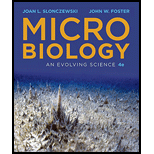
Concept explainers
To review:
Methods of DNA (deoxyribonucleic acid) exchange in microorganisms.
Introduction:
Gene transfer is the method by which a foreign gene is inserted into the cell. Bacteria and other microorganisms acquire genes by this method to acquire useful genes. Horizontal gene transfer or lateral gene transfer is the lateral movement of genes between species. It is different from gene transfer in sexual reproduction in which vertical gene transfer occurs. Horizontal gene transfer can occur in three ways: transformation, transduction, and conjugation.
Explanation of Solution
Microorganisms exchange DNA in three ways:
1. Transformation: It is a method of horizontal gene transfer by which some microorganisms take up the genetic material from the environment. This process only requires the presence of DNA in the environment of the cell. The bacterial cell should be competent enough to take up foreign DNA. After entering the cytoplasm, the DNA may be integrated into the chromosome.
2. Transduction: It is a method in which the genetic material from one bacterial cell is transferred to the other cell by a virus. Bacteriophage is the class of virus which infects the bacterial cell. Bacteriophage transfers its genetic material inside the bacterial cell and uses it as a host to make progeny viruses. Later when this bacteriophage infects the new host, a part of the bacterial DNA may get incorporated into the new host.
3. Conjugation: It is the method of transferring genetic material between bacteria through direct contact. The bacteria that donate the genetic material carry a DNA sequence called F-factor or fertility factor. F-factor helps to form a tubular structure called a pilus. The genetic material is transferred to the recipient cell through the pilus.
Want to see more full solutions like this?
Chapter 9 Solutions
Microbiology: An Evolving Science (Fourth Edition)
- Noggin mutation: The mouse, one of the phenotypic consequences of Noggin mutationis mispatterning of the spinal cord, in the posterior region of the mouse embryo, suchthat in the hindlimb region the more ventral fates are lost, and the dorsal Pax3 domain isexpanded. (this experiment is not in the lectures).a. Hypothesis for why: What would be your hypothesis for why the ventral fatesare lost and dorsal fates expanded? Include in your answer the words notochord,BMP, SHH and either (or both of) surface ectoderm or lateral plate mesodermarrow_forwardNot part of a graded assignment, from a past midtermarrow_forwardNot part of a graded assignment, from a past midtermarrow_forward
- please helparrow_forwardWhat does the heavy dark line along collecting duct tell us about water reabsorption in this individual at this time? What does the heavy dark line along collecting duct tell us about ADH secretion in this individual at this time?arrow_forwardBiology grade 10 study guidearrow_forward
 Human Biology (MindTap Course List)BiologyISBN:9781305112100Author:Cecie Starr, Beverly McMillanPublisher:Cengage Learning
Human Biology (MindTap Course List)BiologyISBN:9781305112100Author:Cecie Starr, Beverly McMillanPublisher:Cengage Learning Biology: The Dynamic Science (MindTap Course List)BiologyISBN:9781305389892Author:Peter J. Russell, Paul E. Hertz, Beverly McMillanPublisher:Cengage Learning
Biology: The Dynamic Science (MindTap Course List)BiologyISBN:9781305389892Author:Peter J. Russell, Paul E. Hertz, Beverly McMillanPublisher:Cengage Learning Biology (MindTap Course List)BiologyISBN:9781337392938Author:Eldra Solomon, Charles Martin, Diana W. Martin, Linda R. BergPublisher:Cengage Learning
Biology (MindTap Course List)BiologyISBN:9781337392938Author:Eldra Solomon, Charles Martin, Diana W. Martin, Linda R. BergPublisher:Cengage Learning Concepts of BiologyBiologyISBN:9781938168116Author:Samantha Fowler, Rebecca Roush, James WisePublisher:OpenStax College
Concepts of BiologyBiologyISBN:9781938168116Author:Samantha Fowler, Rebecca Roush, James WisePublisher:OpenStax College





